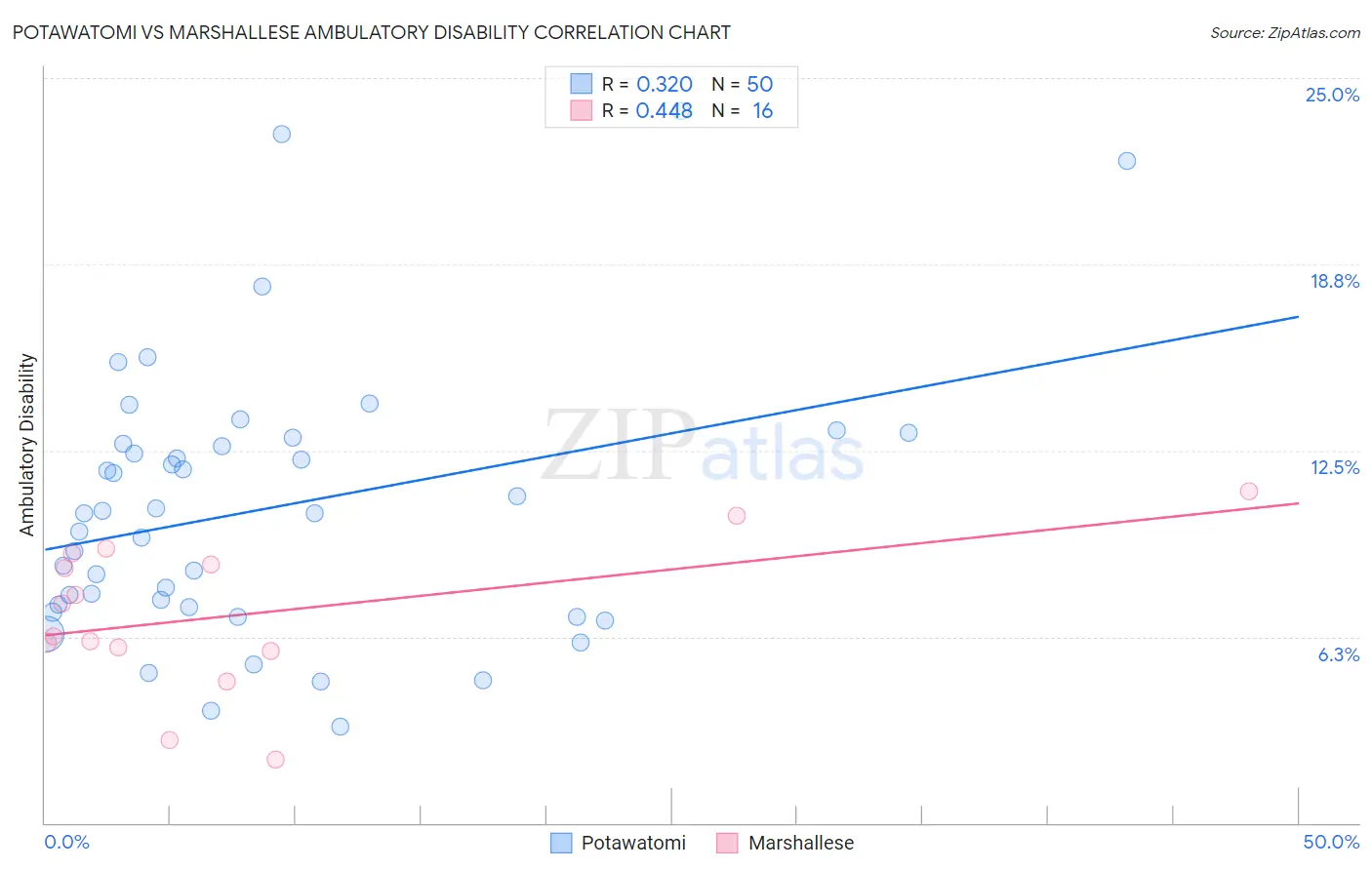Potawatomi vs Marshallese Ambulatory Disability
COMPARE
Potawatomi
Marshallese
Ambulatory Disability
Ambulatory Disability Comparison
Potawatomi
Marshallese
7.3%
AMBULATORY DISABILITY
0.0/ 100
METRIC RATING
320th/ 347
METRIC RANK
6.9%
AMBULATORY DISABILITY
0.0/ 100
METRIC RATING
300th/ 347
METRIC RANK
Potawatomi vs Marshallese Ambulatory Disability Correlation Chart
The statistical analysis conducted on geographies consisting of 117,764,729 people shows a mild positive correlation between the proportion of Potawatomi and percentage of population with ambulatory disability in the United States with a correlation coefficient (R) of 0.320 and weighted average of 7.3%. Similarly, the statistical analysis conducted on geographies consisting of 14,761,315 people shows a moderate positive correlation between the proportion of Marshallese and percentage of population with ambulatory disability in the United States with a correlation coefficient (R) of 0.448 and weighted average of 6.9%, a difference of 5.4%.

Ambulatory Disability Correlation Summary
| Measurement | Potawatomi | Marshallese |
| Minimum | 3.3% | 2.1% |
| Maximum | 23.9% | 11.1% |
| Range | 20.7% | 9.0% |
| Mean | 10.6% | 7.0% |
| Median | 10.4% | 6.8% |
| Interquartile 25% (IQ1) | 7.2% | 5.8% |
| Interquartile 75% (IQ3) | 12.7% | 8.9% |
| Interquartile Range (IQR) | 5.5% | 3.0% |
| Standard Deviation (Sample) | 4.6% | 2.5% |
| Standard Deviation (Population) | 4.6% | 2.4% |
Demographics Similar to Potawatomi and Marshallese by Ambulatory Disability
In terms of ambulatory disability, the demographic groups most similar to Potawatomi are Dominican (7.2%, a difference of 1.9%), Ottawa (7.2%, a difference of 2.2%), Central American Indian (7.2%, a difference of 2.3%), Immigrants from Dominican Republic (7.1%, a difference of 2.4%), and Shoshone (7.1%, a difference of 2.6%). Similarly, the demographic groups most similar to Marshallese are British West Indian (7.0%, a difference of 0.23%), Immigrants from Armenia (7.0%, a difference of 0.28%), African (7.0%, a difference of 0.34%), Immigrants from Cabo Verde (7.0%, a difference of 0.70%), and Immigrants from Micronesia (7.0%, a difference of 0.99%).
| Demographics | Rating | Rank | Ambulatory Disability |
| Marshallese | 0.0 /100 | #300 | Tragic 6.9% |
| British West Indians | 0.0 /100 | #301 | Tragic 7.0% |
| Immigrants | Armenia | 0.0 /100 | #302 | Tragic 7.0% |
| Africans | 0.0 /100 | #303 | Tragic 7.0% |
| Immigrants | Cabo Verde | 0.0 /100 | #304 | Tragic 7.0% |
| Immigrants | Micronesia | 0.0 /100 | #305 | Tragic 7.0% |
| Iroquois | 0.0 /100 | #306 | Tragic 7.1% |
| Spanish Americans | 0.0 /100 | #307 | Tragic 7.1% |
| Chippewa | 0.0 /100 | #308 | Tragic 7.1% |
| Immigrants | Azores | 0.0 /100 | #309 | Tragic 7.1% |
| Arapaho | 0.0 /100 | #310 | Tragic 7.1% |
| Cree | 0.0 /100 | #311 | Tragic 7.1% |
| Delaware | 0.0 /100 | #312 | Tragic 7.1% |
| Immigrants | Yemen | 0.0 /100 | #313 | Tragic 7.1% |
| Blackfeet | 0.0 /100 | #314 | Tragic 7.1% |
| Shoshone | 0.0 /100 | #315 | Tragic 7.1% |
| Immigrants | Dominican Republic | 0.0 /100 | #316 | Tragic 7.1% |
| Central American Indians | 0.0 /100 | #317 | Tragic 7.2% |
| Ottawa | 0.0 /100 | #318 | Tragic 7.2% |
| Dominicans | 0.0 /100 | #319 | Tragic 7.2% |
| Potawatomi | 0.0 /100 | #320 | Tragic 7.3% |